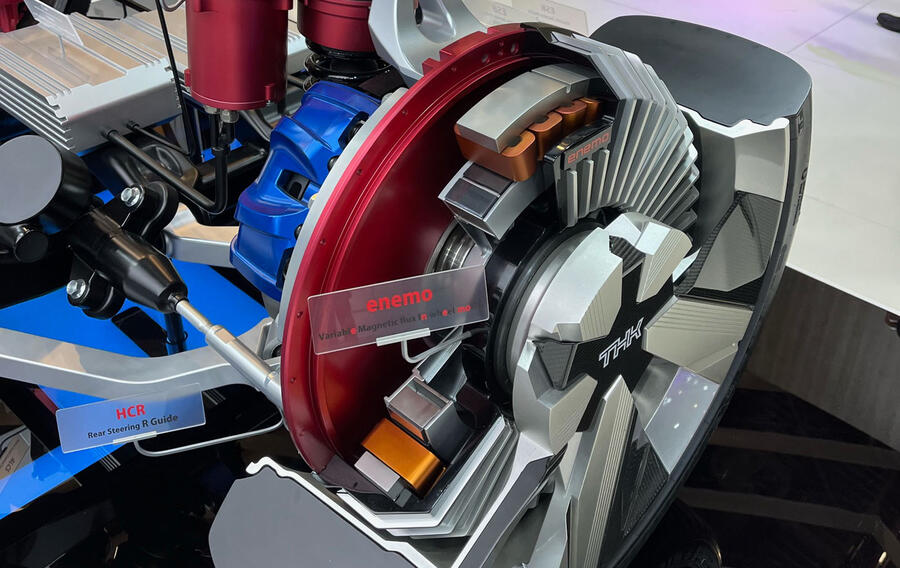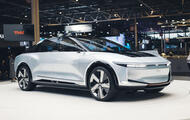Japanese supplier THK’s LSR-05 concept demonstrates what’s possible with in-wheel motors
In-wheel motor maker Protean reckons it will be a £17 billion market by the middle of the next decade
On a corner of the Renault Group stand at the recent Paris motor show stood the perfect use case for in-wheel motors. The company had stripped the body panels from its new Duo/Bento quadricycle – the replacement for the Twizy – and a large caged area between the rear wheels, incorporating the e-axle with an electric motor and driveshafts, was visible.
Without that, the Bento van version could have repurposed the space to vastly increase its luggage capacity. Or it could have been a usable boot for the Duo passenger model.
In the next hall, Japanese supplier THK had brought a concept vehicle created by famed ex-Nissan designer Shiro Nakamura that showcased exactly what could be achieved if you did fit in-wheel motors. Without an e-axle, the boot was deep and roomy in a way that few EVs have so far been. “Putting those functions in the corner of the car means the entire size [of the] automobile can be fully used for other purposes like roominess or comfort,” Nakamura told Autocar.
In-wheel motors have shown promise but commercial applications have been few and far between. They featured in the innovative Nissan Bladeglider sports car, which remained a concept. They were to have powered the doomed Lordstown electric pick-up, supplied by Slovakia’s Elaphe. The Dutch Lightyear solar car was also to have used Elaphe in-wheel motors before it too succumbed to financial realities.
So far, commercial uses have been confined mainly to electric bicycles or e-scooters but the as yet untapped promise for bigger vehicles is coming closer to reality.
Competitors to THK and Elaphe include the UK’s in-wheel motor champion, Protean Electric, which has just launched its fifth-generation version of the technology.
Meanwhile in Germany, start-up DeepDrive has received investment from BMW as well former Audi and Volvo technical head Peter Mertens, who is also an advisor.
Over in Korea, Hyundai Motor and Kia are working on the ‘Uni Wheel’ system that it calls a ‘paradigm-shifter’ for its ability to free up space, either for luggage or more batteries.
In-wheel motors are starting to move out of the prototype phase. Protean owner Bedeo has used them in a kit to convert classic Land Rover Defenders to electric. The company’s technology has also been used to create a plug-in hybrid version of the Fiat Ducato-based Trigano motorhome, with the existing rear wheels switched out for ones with in-wheel motor hubs that add electric drive and energy recovery. And in the US, a lorry trailer company is using them to harvest braking energy to feed new electric refrigerating units that replace diesel versions.
In China, state-owned car-making giant Dongfeng is testing a four-wheel-drive version of its Fengshen E70 saloon that uses Protean motors at the rear to create a second driven axle without a major overhaul to the car’s engineering. Protean’s factory in Tianjin, China, has the capacity to build 5000 motors annually.
All of the in-wheel motor makers tout their differentiating features. For example, THK’s Enemo variable-flux motors, pictured below, decouple the stator in a version of cylinder deactivation to avoid the problem of creating electricity at high speed. DeepDrive’s set-up has a dual-rotor system, with the stator driving both rotors and increasing the torque to a claimed 1770lb ft, even more than the 1500lb ft Protean measures from its 138bhp motor.

Unsprung weight (weight not controlled by the suspension) is an issue with in-wheel motors, with THK’s system weighing 80kg per corner, DeepDrive’s 60kg and Protean’s system a comparatively flyweight 39kg, according to the company.
THK’s system is aimed at a more premium market, with 800V capability and 125bhp per corner. In the LSR-05 concept car, the company paired the system with adaptive dampers to try to offset any negative effects from the weight disadvantage. Protean and DeepDrive say they’re ready for more volume cars, with the potential weight saving from the more compact packaging as well as lower transmission losses helping to increase electric range.
Advantages such as individual torque control per wheel come into the category of ‘nice to have’ rather than a big sales pitch. “It’s a free gimmick, frankly,” Andrew Whitehead, Protean Electric’s CEO, told Autocar. The weight saving, packaging and potential range increase are the key selling points to car makers. Elaphe reckons they increased range from the same battery pack by 36% with better vehicle packaging and fewer transmission losses.
It’s still a hard pitch, given that everyone is trying to cut costs. “Trying to convince an auto maker to use something that’s even more expensive is almost impossible,” said Whitehead. “We have to provide two in-wheel motors at a comparable cost with an e-axle, with its inverter, a motor, gearbox and driveshafts.”
Providing a system cheap enough for Renault to install in something as low cost as the Duo two-seater seen at the Paris show is not yet viable for Protean. However, it does believe it can compete with 800V set-ups with pricey silicon-carbide invertors.
“Electric axles have been riding down that cost curve for the last 15 years. We’re still at the top end,” said Whitehead. “We will start to come down over the next five to 10 years and then be able to compete with an increasingly large segment of the market.”
Protean reckons by the middle of next decade, in-wheel motors will be a €20 billion (£17bn) market globally, but before that can happen, car makers need to be really convinced the tech can become a viable alternative.
Ideally, they will build platforms to take full advantage of the packaging benefits. “To be convinced, the OEMs need to think of a world where you’re not propelling the vehicle with e-axles: you’re propelling it just with in-wheel motors. The end goal has to be clear,” said Whitehead. Plenty are testing the product right now, Whitehead said, without giving more detail.
THK reckons European car makers are the perfect target, more so than its native Japan. “In Japan, we have certain interests in new technology but we are more conversative,” CEO Akihiro Teramachi told Autocar at Paris. “In Europe, they are more open to new features.”
Source: Autocar
